Abstract
Colloidal structures in confined nematics offer novel routes for designing complex optical materials with micrometre and submicrometre functionality. In this paper, we review some of our recently assembled colloidal structures that form in confined nematic cells. We present effective elastic binding via nematic distortion as a mechanism for the assembly of two-dimensional colloidal crystals of elastic dipoles and elastic quadrupoles. We introduce entangled colloids as novel types of structures, where particles are topologically bound by delocalised defect loops, producing robust and possibly chiral structures. The concept of hierarchical assembly is demonstrated in colloids with particles of various scales. In cholesteric blue phases, the assembly of three-dimensional colloidal crystals is shown based on naturally occurring three-dimensional arrays of trapping sites produced by blue phases.
1. Introduction
Liquid crystal colloids are novel materials (Citation1–3) with promising applications in optics, including photonic crystals (Citation 4 ), tunable lasers (Citation 5 ) and metamaterials (Citation 6 ). They can be used to design optical patterns at scales ranging from nanometres to micrometres, using self-assembly (Citation 7 ), application of external fields (Citation 8 , Citation 9 ) and trapping by domain boundaries (Citation 10 ).
The current main research focus in liquid crystal colloids is on nematic-based materials, which can provide for large-scale assembly of chains (Citation 2 ), clusters (Citation 11 ), two-dimensional (2D) lattices at interfaces (Citation 12 , Citation 13 ) and 2D colloidal crystals (Citation 7 ). Additionally, such colloidal assemblies have been functionalised by using facetted particles (Citation 14 , Citation 15 ), ellipsoids (Citation 16 ), rods (Citation 17 ) and Janus particles (Citation 18 ). Recently, chiral cholesteric and blue phase colloids are also attracting growing interest. Self-organisation of planar particles in cholesteric (Citation 19 ), size-dependent defects and non-Stokesian microrheology (Citation 20 ), stabilisation of blue phases by nanoparticles (Citation 21 , Citation 22 ) and stabilisation of blue phases by guest components (Citation 23 ) have been demonstrated. This growing interest in blue phases was started by applications and recent advances in materials synthesis. Blue phase materials with a wide temperature range have been synthesised (Citation 24 ), where flexoelectricity was interpreted as an important contributor to the phase stabilisation (Citation 25 ). Blue phase materials can yield high switching times, which is attractive for display applications (Citation 26 ).
Experimental methods for the 2D assembly of colloidal particles in liquid crystals are typically based on: (i) manipulation of individual particles by laser tweezers (Citation 9 , Citation27–30); (ii) control of dispersions of multiple particles by external fields (Citation 31 , Citation 32 ) or concentration and temperature (Citation 33 ). Approach (i) typically gives highly regular structures; however, it is currently limited to, for macroscopic technological applications, relatively small numbers of particles (∼<103, (Citation 7 )) because of the complex and non-automated individual manipulation of particles. Approach (ii) can give structures with a much larger number of inclusions; however, its limitations are typically the strongly bound metastable structural defects in the assemblies of particles.
Theoretically, liquid crystal colloids are approached differently, depending on the typical scales of the considered system. In a molecular-scale system of ˜105 molecules, effective molecular potentials are used to describe intermolecular and inclusion-molecular interactions. As an example, the Gay–Berne model (Citation 34 ) uses an effective potential based on Lenard-Jones interaction centres and has embedded within it translational and rotational degrees of freedom as well as the thermality of the system. Increasing the size of the system, lattice ‘spin’ models are used, for example the Lebwohl–Lasher model, where a single spin at a chosen lattice point describes an effective cluster of ˜100 molecules (Citation 35 , Citation 36 ). The ‘spins’ are thermal and interact one with another via an anisotropic potential, but have no translational degree of freedom. At submicrometre and micrometre scales, phenomenological continuum approaches based on the free energy functionals become reliable. They use experimentally measured phenomenological material constants and usually need to be solved numerically, by approaches such as the finite difference (Citation37–40), finite element (Citation 41 ) or lattice Boltzmann methods (Citation 42 ). Alternatively to free-energy-based approaches, density functional theory can be applied where liquid crystal is considered to be a suspension of hard-core particles, for example ellipsoids (Citation 43 ).
In this paper, I review our recent theoretical advances in the assembly of nematic and chiral nematic colloids as part of my Glenn H. Brown Prize. The advances reflect the joint research work of groups at the University of Ljubljana (S. Zumer), the Josef Stefan Institute (I. Musevic) and the University of Oxford (J.M. Yeomans). More specifically, the binding mechanism for the 2D crystalline structures of individual particle conformations, i.e. elastic dipoles and elastic quadrupoles, is addressed. Entangled nematic colloids are presented as a novel robust method for assembly of particles by delocalised defect lines. Next, the entangled assembly is generalised to the hierarchical assembly of particles of various sizes. Finally, self-assembly of three-dimensional (3D) colloidal crystals in cholesteric blue phases is presented.
2. Theory and modelling of nematic colloids
A strong method for studies of nematic liquid crystal colloids at micrometre or submicrometre particle scales is the Landau–de Gennes (LdG) theory (Citation 44 ). It is based on the order parameter tensor Qij , which incorporates orientational ordering of the nematic molecules, their fluctuations and the biaxiallity of fluctuations. These correspond to macroscopic space-dependent fields - respectively, the director, nematic degree of order and biaxiallity. Using the full order parameter tensor proves to be an important advantage when modelling confined nematic systems as it naturally provides for formation of nematic defects by allowing the variations in the degree of order of the nematics. LdG modelling is a phenomenological approach which constructs a free energy functional F that ascribes free energy contributions to three basic phenomena that characterise nematic colloids: the nematic elasticity fe , nematic ordering ford and surface coupling fs . The total free energy F reads
The total free energy F is minimised according to the Euler–Lagrange formalism yielding a set of six partial differential equations. The equations are solved numerically by an explicit relaxation algorithm on a cubic mesh (Citation 39 ). Colloidal surfaces are described as shells of thickness determined by the mesh resolution (typically 10 nm).
A strong point of phenomenological modelling is that the free energy can be simply extended for novel system-specific physical phenomena by adding additional free energy contributions and introducing additional phenomenological constants. In the last section of this paper, colloidal assembly in cholesteric blue phases will be presented and blue phases are chiral nematic liquid-crystalline materials. In order to account for chirality, the elastic free energy density fe is extended by a chiral term and the pitch of the chiral nematic in the cholesteric phase p 0=2π/q 0 is a new phenomenological constant. q 0 is the inverse pitch. The elastic free energy for a chiral nematic fe chir reads
where ϵijk is the Levi-Civita totally asymmetric tensor.
In the presented calculations (if not stated otherwise) the following parameter values are used: A = –0.172 MJ/m3, B = –2.12 MJ/m3, C = 1.73 MJ/m3, W = 10−2 J/m2, the cell thickness is 2 μm, the particle diameter 2R = 1 μm and L = 4 × 10−11 N. The preferential surface order parameter tensor was chosen to be uniaxial with its primary axis being perpendicular to the particle surfaces and the degree of order being equal to the equilibrium bulk value (S = 0.533).
3. Assembly of colloidal structures in nematics and chiral nematics
3.1 Structures of elastic dipoles and quadrupoles
Two characteristic nematic configurations form around single particles with homeotropic surface anchoring: an elastic dipole or an elastic quadrupole (see ). These structures are well known from the literature (Citation 45 ) and can be interpreted using the analogy of the director field profile with an electrostatic potential. Generically, larger particles with stronger surface anchoring form elastic dipoles, whereas smaller particles with weaker surface anchoring form elastic quadrupoles (Citation 3 ). The elastic dipoles and quadrupoles can be transformed one into another by varying the effective confinement of the director field, which can be realised by either applying an external electric or magnetic field, or by changing the cell thickness.
Figure 1. Elastic dipole and quadrupole. The nematic material around the particles with homeotropic surface anchoring adopts the profile characterised by a hyperbolic point defect ((a), the elastic dipole) or a -1/2 Saturn ring defect loop ((b), the elastic quadrupole).
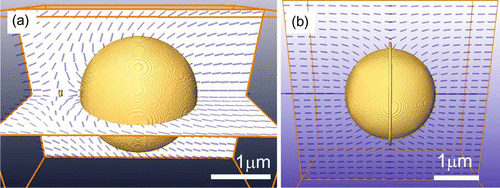
In dispersions of multiple particles, the particle-induced deformations of the director field, such as the dipole and quadrupole in , generate interparticle potentials. These effective elastic potentials are naturally anisotropic in their nature and are attractive or repulsive, depending on the energetically favourable or non-favourable coupling of the deformations produced by the two interacting particles. It is these effective elastic deformations that can bind individual elastic dipoles and quadrupoles into 2D colloidal crystals () (Citation 7 ). The central element of the dipolar crystals are anti-parallel dipolar chains, which can be seen from the alternating left-right bending of the director in the sequent vertical planes in (a). They assemble in an anti-ferroelectric way creating a regular crystalline array of particles. Not showing any quantitative results for the binding potentials of the dipolar crystal, we should comment that typical binding energies between the particles are of the order of a few 1000 kT per particle. 2D quadrupolar colloidal crystals are shown in (b). Here, the four particle rhomb is the basic building block that determines the cell vectors. In the quadrupolar crystal the binding potentials are weaker compared to the dipolar case typically having binding energies of only a few 100 kT per particle. The numerically modelled crystalline structures in are in good agreement with the experiments (Citation 46 , Citation 47 ).
Figure 2. 2D dipolar and quadrupolar colloidal crystals. (a) Dipolar colloidal crystals form as sheets of anti-parallel chains of elastic dipoles. The lattice is rectangular with basis of two position vectors (one for each particle within the unit cell). (b) Quadrupolar colloidal crystals form a roughly hexagonal lattice of particles.
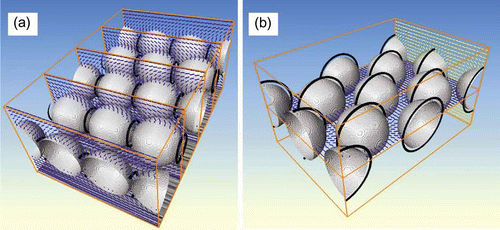
3.2 Entangled colloids
In addition to elastic dipoles and quadrupoles, recently entangled colloidal structures were found where particles are bound by delocalised entangled defect loops (Citation 48 , Citation 49 , Citation 38 ). These structures are typically higher in the total free energy when compared to either dipoles or quadrupoles and are thus metastable, separated by an energy barrier from the structures of elastic dipoles and quadrupoles. Experimentally, the barrier can be breached by performing a local isotropic–nematic temperature quench of two or more closely spaced particles. Within numerical modelling, this corresponds to initialising the calculations with a locally random orientation of director spins and then relaxing the system to equilibrium.
Three different metastable entangled dimer structures were found: a figure of eight, an entangled hyperbolic defect structure and a figure of omega. shows experimentally and numerically the assembled structures using the local temperature quench. In the figure of eight and figure of omega configurations, a single –1/2 defect line winds around two particles and interlinks them in a new topological object. In the entangled hyperbolic defect structure, two separate perpendicular –1/2 defect rings are involved, yet again the larger loop topologically interlinks the two particles.
Figure 3. Entangled colloidal dimers. (a) The figure of eight entangled colloidal pair is assembled by a thermal quench using laser tweezers. The diameter of the particles is 19 μm, the cell thickness is 21 μm. (b) Numerical simulation of the time evolution of entanglement, measured by the number of iteration steps. Defects are represented by drawing the surfaces of constant order parameter S (coloured red, corresponding to S = 0.5). (c) Evolution of the figure of omega entangled state. (d) The figure of omega was unstable and transformed into the entangled hyperbolic defect. (e) The calculated figure of eight structure. (f) A close-up look at the director field in the gap between the microspheres for the figure of eight. (g) The calculated figure of omega structure. (h) The calculated entangled hyperbolic defect structure. Reproduced with permission from Ravnik, M.; Skarabot, M.; Zumer, S.; Tkalec, U.; Poberaj, I.; Babic, D.; Osterman, N.; Musevic, I. Phys. Rev. Lett. 2007, 99, 247801. Copyright 2007 by the American Physical Society.
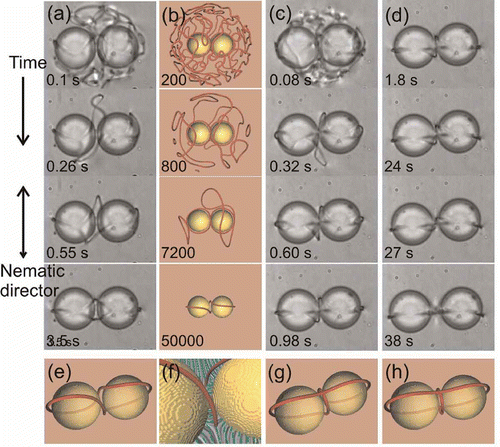
The entanglement of colloidal particles was generalised to clusters and to 2D entangled colloidal crystals (Citation 50 ). To generate entangled defect configurations, a numerical temperature quench from the isotropic to nematic phase was performed in a unit cell of a 2D colloidal crystal. A rectangular simulation box, periodic in the lateral x and y directions was chosen, with a total of 2 (1 + 4 × ¼ = 2) particles. shows the equilibrium entangled structures obtained by temperature quenching for fixed particle positions. Particles are positioned in a hexagonal-close-packed lattice with interparticle separations of ∼40 nm. The delocalised defect lines can attain various motifs which can be effectively classified as: (i) closed loops already within the unit cell; (ii) entangled lines in a co-linear direction; and (iii) entangled lines in non-co-linear directions. It is (iii) that are the true 2D entangled structures, as defect lines would need to be cut in order to disintegrate the whole structure.
Figure 4. 2D entangled colloidal crystals. Delocalised disclination lines interlink multiple particles in non-co-linear directions forming topologically bound colloidal structures, or defect braids. Particles are at fixed positions forming a 2D hexagonal-close-packed lattice.
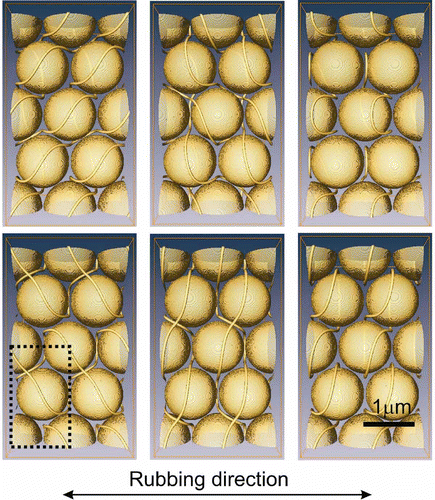
Indeed, the entangled colloidal structures can be considered as new basic building blocks, since they cannot continuously transform into separate dipolar or quadrupolar structures. Entangled colloids offer the assembly of a novel robust type of colloidal materials since these structures are inherently ∼1 order of magnitude stronger bound than the ‘non-entangled’ nematic colloids. Interestingly, entangled colloids also offer the formation of a chiral director profile in the colloidal structure.
3.3 Hierarchical colloids
In materials science, hierarchy is an interesting phenomenon where material parameters at a given larger scale control material response at a different smaller scale (Citation 51 ). Scale refers typically to either energy or physical size but can be generalised to almost any physical quantity. Liquid crystal colloids are systems which can be hierarchically ordered (Citation 52 ).
The director deformation in a nematic produced by particles of a given size spans a length scale given by the size of the particles. Therefore, making a dispersion of particles of multiple scales, i.e. various sizes, the smaller particles will only be able to poorly affect the nematic profile on their own small scale, being thus subjected to the hierarchically imposed profile produced by larger particles at their scale. By using colloidal particles of two sizes, i.e. two length scales, we can thus build colloidal superstructures where the larger particles control the assembly of smaller-scale particles. shows an example of such an hierarchical assembly of a figure of eight colloidal superstructure where smaller particles are trapped in the entangled defect loop stabilised by two larger particles.
Figure 5. Hierarchical colloidal assembly. (a) Smaller colloidal particles of 2.32 μm are attracted into the figure of eight defect loop. (b) The potential of smaller colloidal particles in the vicinity of the figure of eight. (c) The trapping sequence of smaller 100 nm particles into the figure of eight defect formed around a pair of 1 μm particles. Step 0 corresponds to the initial configuration and step 24 to the final configuration in the quasidynamical relaxation. Reproduced with permission from Skarabot, M.; Ravnik, M.; Zumer, S.; Tkalec, U.; Poberaj, I.; Babic, D.; Musevic, I. Phys. Rev. E: Stat. Nonlinear, Soft Matter Phys. 2008, 77, 061706. Copyright 2008 by the American Physical Society.
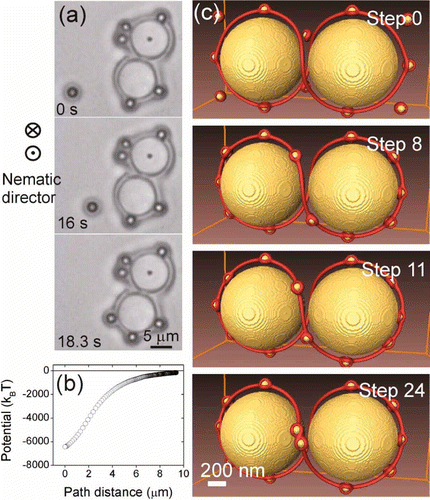
3.4 Three-dimensional blue phase colloidal crystals
Blue phases form in chiral nematic materials as a result of the spatial frustration as chiral molecules attempt to form helical order in more than one spatial direction. This leads to the formation of highly non-uniform and complex director patterns in the shape of double twist cylinders and to the formation of distinct networks of –1/2 defect lines (Citation 53 ). There are three distinct thermodynamically stable blue phases. Despite being liquid materials, both the blue phase I (BPI) and the blue phase II (BP II) exhibit full 3D crystalline orientational order corresponding to the cubic space groups O8− and O2, respectively. Moreover, this crystalline regularity of the intrinsic blue phase patterns is the material characteristic which we use for the assembly of 3D colloidal crystals.
Defect lines are threaded regularly in blue phases, so they produce a regular 3D array of effective trapping sites for colloidal particles (Citation 54 ). Similarly, the defect loop attracts particles in the hierarchical assembly in . Colloidal crystals with various numbers of particles per unit cell can form depending on the efficiency of the filling of the trapping sites (Citation 55 ). The structure with the lowest free energy depends on the material characteristics and primarily on the size of the particles. In , we show the face-centred-cubic colloidal crystal in BP I and the body-centred-cubic colloidal crystal in BP II, for several particle sizes. Note how smaller particles can immerse well into the defect lines, whereas larger particles cover the defect lines much less effectively. Interestingly, it is exactly this coverage of defects by colloidal particles that can thermodynamically stabilise blue phases, increasing their temperature range by factors of 2 or more (Citation 55 ).
Figure 6. 3D blue phase colloidal crystals for various particle sizes. (upper panels) Face-centred-cubic colloidal crystals assembled in BP I. (lower panels) Body-centred-cubic colloidal crystals assembled in BP II. 2 × 2 × 2 unit cells are shown. Defects are visualised as iso-surfaces of S = 0.24 in BP I and S = 0.09 in BP II. The following parameter values characteristic for a typical chiral nematic were used: L = 2.5 × 10−11 N, A = A 0(1 - γ/3), B=-A 0γ, C=A 0γ, A 0 = 1.02 × 105 J/m3, W = 1 × 10−4 J/m2 (γ = 3.375, p 0 = 2π/q 0 = 0.566 μm) in BP I and (γ = 2.755, p 0 = 2π/q 0 = 0.616 μm) in BP II.
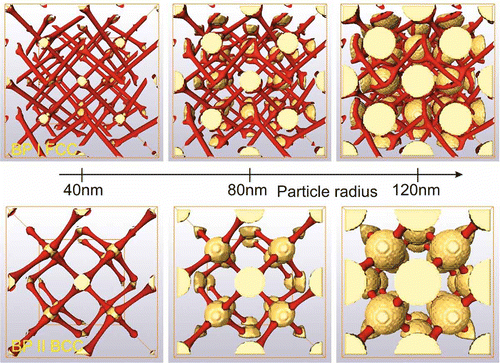
4. Conclusions
Several advances in the assembly of colloidal structures in nematic and chiral nematic materials are reviewed. Starting from simple single dipolar and quadrupolar homeotropic particles, we demonstrate the assembly of 2D dipolar and quadrupolar colloidal crystals. We introduce entangled nematic colloids – particles bound by delocalised defect loops – as a novel topological method for binding of robust colloidal structures. Three basic entangled dimers and several entangled 2D colloidal crystals are presented. We comment on the hierarchical assembly in nematics and show that by using particles of multiple scales/sizes colloidal superstructures can be assembled. Finally, we present a novel route for the assembly of 3D colloidal crystals using cholesteric blue phases as effective 3D arrays of trapping sites.
Acknowledgements
This research was financially supported by the Slovenian Office of Science (P1- 0099), EU network HIERARCHY and the Center of Excellence NAMASTE. MR acknowledges support of the EC under the Marie Curie Programme ACTOIDS; the content reflects only the author's views and not the views of the EC. The author is indebted to his advisor Slobodan Zumer for his invaluable support. The author would like to thank I. Musevic, M. Skarabot, U. Tkalec, I. Poberaj, D. Babic and N. Osterman for their experimental contribution to this work, and J.M. Yeomans and G.P. Alexander for their theoretical work on blue phase colloids.
References
- Poulin , P. , Stark , H. , Lubensky , T.C. and Weitz , D.A. 1997 . Science , 275 : 1770 – 1773 .
- Loudet , J.C. , Barois , P. and Poulin , P. 2000 . Nature (London, UK) , 407 : 611 – 613 .
- Stark , H. 2001 . Phys. Rep. , 351 : 387 – 474 .
- Hellweg , T. 2009 . Angew. Chem. Int. Ed. , 48 : 6777 – 6778 .
- Humar , M and Musevic , I. 2010 . Opt. Express , 18 : 26995 – 27003 .
- Yao , J. , Liu , Z. , Liu , Y. , Wang , Y. , Sun , C. , Bartal , G. , Stacy , A.M. and Zhang , X. 2008 . Science , 321 : 930
- Musevic , I. , Skarabot , M. , Tkalec , U. , Ravnik , M. and Zumer , S. 2006 . Science , 313 : 954 – 958 .
- Lavrentovich , O.D. , Lazo , I. and Pishnyak , O.P. 2010 . Nature (London, UK) , 467 : 947 – 950 .
- Yada , M. , Yamamoto , J. and Yokoyama , H. 2004 . Phys. Rev. Lett. , 92 : 185501
- Zapotocky , M. , Ramos , L. , Poulin , P. , Lubensky , T.C. and Weitz , D.A . 1999 . Science , 283 : 209 – 212 .
- Poulin , P. and Weitz , D.A . 1998 . Phys. Rev. E: Stat., Nonlinear, Soft Matter Phys. , 57 : 626 – 637 .
- Nazarenko , V.G. , Nych , A.B. and Lev , B.I. 2001 . Phys. Rev. Lett. , 87 : 075504
- Smalyukh , I.I. , Chernyshuk , S. , Lev , B.I. , Nych , A.B. , Ognysta , U. , Nazarenko , V.G. and Lavrentovich , O.D . 2004 . Phys. Rev. Lett. , 93 : 117801
- Lapointe , C.P. , Mason , T.G. and Smalyukh , I.I. 2009 . Science , 326 : 1083 – 1086 .
- Hung , F.R. and Bale , S. 2009 . Mol. Simul. , 35 : 822 – 834 .
- Mondiot , F. , Prathap Chandran , S. , Mondain-Monval , O. and Loudet , J.-C. 2009 . Phys. Rev. Lett. , 103 : 238303
- Tkalec , U. , Skarabot , M. and Musevic , I. 2008 . Soft Matter , 4 : 2402 – 2409 .
- Conradi , M. , Ravnik , M. , Bele , M. , Zorko , M. , Zumer , S. and Musevic , I. 2009 . Soft Matter , 5 : 3905 – 3912 .
- Hijnen , N. , Wood , T.A. , Wilson , D. and Clegg , P.S. 2010 . Langmuir , 26 : 13502 – 13510 .
- Lintuvuori , J.S. , Stratford , K. , Cates , M.E. and Marenduzzo , D. 2010 . Phys. Rev. Lett. , 105 : 178302
- Yoshida , H. , Tanaka , Y. , Kawamoto , K. , Kubo , H. , Tsuda , T. , Fujii , A. , Kuwabata , S. , Kikuchi , H. and Ozaki , M . 2009 . Appl. Phys.Express , 2 : 121501
- Karatairi , E. , Rozie , B. , Kutnjak , Z. , Tzitzios , V. , Nounesis , G. , Cordoyiannis , G. , Thoen , J. , Glorieux , C. and Kralj , S . 2010 . Phys. Rev. E: Stat., Nonlinear, Soft Matter Phys. , 81 : 041703
- Fukuda , J. 2010 . Phys. Rev. E: Stat., Nonlinear, Soft Matter Phys. , 82 : 061702
- Coles , H.J. and Pivnenko , M.N. 2005 . Nature (London, UK) , 436 : 997 – 1000 .
- Castles , F. , Morris , S.M. , Terentjev , E.M. and Coles , H.J. 2010 . Phys. Rev. Lett. , 104 : 157801
- Seminar and Exhibition presented at the Society for Information Display (SID) 2008 International Symposium (Los Angeles, 2008)
- Muševič , I. , Skarabot , M. , Babic , D. , Osterman , N. , Poberaj , I. , Nazarenko , V. and Nych , A. 2004 . Phys. Rev. Lett. , 93 : 197801
- Gleeson , H.F. , Wood , T.A. and Dickinson , M. 2006 . Phil. Trans. R. Soc. A , 364 : 2789 – 2805 .
- Lapointe , C.P. , Hopkins , S. , Mason , T.G. and Smalyukh , I.I. 2010 . Phys. Rev. Lett. , 105 : 178301
- Kotar , J. , Vilfan , M. , Osterman , N. , Babic , D. , Copic , M. and Poberaj , I. 2006 . Phys. Rev. Lett. , 96 : 207801
- Skarabot , M. , Tkalec , U. and Musevic , I. 2007 . Eur. Phys. J. E , 24 : 99 – 107 .
- Loudet , J.C. and Poulin , P. 2001 . Phys. Rev. Lett. , 87 : 165503
- Loudet , J.C. , Barois , P. , Auroy , P. , Keller , P. , Richard , H. and Poulin , P. 2004 . Langmuir , 20 : 11336
- Lockhurst , G.R. , Stephens , R.A. and Phippen , E.W. 1990 . Liq. Cryst. , 8 : 451 – 464 .
- Lebwohl , P.A. and Lasher , G. 1972 . Phys. Rev. A: At., Mol., Opt. Phys. , 6 : 426 – 429 .
- Skacej , G. and Zannoni , C. 2008 . Phys. Rev. Lett. , 100 : 197802
- Fukuda , J.-I. 1998 . Eur. Phys. J. B , 1 : 173 – 177 .
- Araki , T. and Tanaka , H. 2006 . Phys. Rev. Lett. , 97 : 127801
- Ravnik , M. and Zumer , S. 2009 . Liq. Cryst. , 36 : 1201 – 1204 .
- Svensek , D. and Zumer , S. 2002 . Phys. Rev. E: Stat., Nonlinear, Soft Matter Phys. , 66 : 021712
- Barrett , J.W. , Feng , X. and Prohl , A. 2006 . M2AN , 40 : 175 – 199 .
- Denniston , C. , Marenduzzo , D. , Orlandini , E. and Yeomans , J.M. 2004 . Phil. Trans. R. Soc. Lond. A , 362 : 1745 – 1754 .
- Cheung , D.L. and Allen , M.P. 2008 . Langmuir , 24 : 1411 – 1417 .
- de Gennes , P.G. and Prost , J. 1993 . The Physics of Liquid Crystals , 2nd , Oxford : Oxford Science Publications .
- Lubensky , T.C. , Pettey , D. , Currier , N. and Stark , H. 1998 . Phys. Rev. E: Stat., Nonlinear, Soft Matter Phys. , 57 : 610 – 625 .
- Skarabot , M. , Ravnik , M. , Zumer , S. , Tkalec , U. , Poberaj , I. , Babic , D. , Osterman , N. and Musevic , I . 2007 . Phys. Rev. E: Stat., Nonlinear, Soft Matter Phys. , 76 : 051406
- Skarabot , M. , Ravnik , M. , Zumer , S. , Tkalec , U. , Poberaj , I. , Babic , D. , Osterman , N. and Musevic , I . 2008 . Phys. Rev. E: Stat., Nonlinear, Soft Matter Phys. , 77 : 031705
- Ravnik , M. , Skarabot , M. , Zumer , S. , Tkalec , U. , Poberaj , I. , Babic , D. , Osterman , N. and Musevic , I. 2007 . Phys. Rev. Lett. , 99 : 247801
- Hung , F.R. 2009 . Phys. Rev. E: Stat., Nonlinear, Soft Matter Phys. , 79 : 021705
- Ravnik , M. and Zumer , S. 2009 . Soft Matter , 5 : 4520 – 4525 .
- Erb , R.M. , Son , H.S. , Samanta , B. , Rotello , V.M. and Yellen , B.B. 2009 . Nature (London, UK) , 457 : 999 – 1002 .
- Skarabot , M. , Ravnik , M. , Zumer , S. , Tkalec , U. , Poberaj , I. , Babic , D. and Musevic , I. 2008 . Phys. Rev. E: Stat., Nonlinear, Soft Matter Phys. , 77 : 061706
- Wright , D.C. and Mermin , N.D. 1989 . Rev. Mod. Phys. , 61 : 385 – 432 .
- Ravnik , M. , Alexander , G.P. , Yeomans , J.M. and Zumer , S. 2010 . Faraday Discuss. , 144 : 159 – 169 .
- Ravnik , M. , Alexander , G.P. , Yeomans , J. and M; Zumer , S. 2011 . Proc. Natl. Acad. Sci. Vol. 108 , 5188 – 5192 . USA